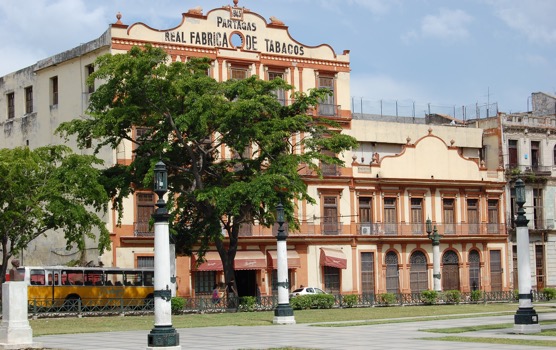According to legend, President Kennedy was partial to the H. Upmann brand of petit corona cigars. He enjoyed them so much he made a point to buy as many as possible up before it was too late. Sending his press secretary, JFK bought all of his favorite smokes within the Washington, D.C. area on February 6, 1962—the night before enacting the Cuba trade embargo. In the end, Kennedy collected around 1,200 cigars before signing the law into place on February 7.
While restored diplomatic ties between the U.S. and Cuba have brought a wave of travel interest to the destination known for producing world class cigars, don’t get too excited. The trade embargo is technically still in place.
However, the inability to stock up on stogies is the perfect excuse to plan a trip. If you are ready to pack your bags, you are in good company. Below is brief history and tutorial about cigar making and the best locations to enjoy the process when you arrive 90 miles south of Florida.
1. A Cure for What Ails You
The process of curing tobacco leaves after harvest usually takes around one or two months. In an effort to keep larger leaves from rotting, a combination of heat and shade reduces water and sugar content within the plant.
2. Smoke ‘em If You Got ‘em

Photo: Flickr/Thomas Münter
The second step is carefully fermenting—without disintegrating—the tobacco. Slowly drying the leaves determines the flavor and aromatic qualities of the cigar. Determined by color and appearance, the product is sorted to be used as filler or wrapper. Typically, the darker the tobacco, the more flavorful the smoke.
3. No Leaf Unturned
Tobacco leaves are baled to dry, inspected, and lastly un-baled to check appearance for categorization or to be cycled through again. Once the manufacturer’s expectations are met, the leaves are stripped from the stalk.
4. Wrap It Up

Photo: Flickr/Thomas Münter
The highest quality cigars are completely hand crafted by torcedores or those employed to skillfully roll. While all Cuban cigars exclusively consist of Cuban tobacco, premium brands use varieties from around the island. This allows the most attractive and tender leaves to be used for the wrapper.
5. Choose Your Style
There are seven colors or strengths of cigars as well as fourteen diameters to decide upon. It should be noted that the color of the wrapper does not mean the cigar will be strong or weak. That is determined by the filler tobacco. Finally, consider the time you want to spend smoking before lighting up. If you plan to have less than an hour, opt for a shorter cigar.
6. A Soothing Voice

Photo: Flickr/Stuart Rankin
Traditional cigar factories still have readers known as lectores on staff. This practice is less common outside of Cuba however. Readers were originally chosen by fellow cigar rollers to read aloud as everyone worked. Choosing someone with the ability to read and a pleasant voice, the rollers would then pay the lector from their own salary. The group usually tunes into the newspaper for current events in the first half of the day and chooses a novel for the second half.
7. Outside the Box
The brand mentioned earlier, H. Uppman, which Kennedy enjoyed, opened in 1844. Uppman is credited for first encasing cigars in cedar boxes. This style of packaging brought notoriety to the brand winning seven gold medals displayed on today’s boxes. In later years, the H. Uppman factory merged into the same building as another notable cigar company- Romeo y Julieta. For architecture lovers, step back in time with a trip to the H. Uppman and Romeo y Julieta factory.
8. History + Innovation

Photo: Flickr/Pascal Hassenforder
Now 170 years old, the original Partagás factory is located in Havana although there is a competing brand of the same name in the Dominican Republic. Don Jaime Partagás is known for hiring one of the first lectores in the business. This innovative factory is the one to visit for history buffs. With currency exchange roughly equal, the entrance fee is 10 Cuban Convertible Pesos, or $10.
9. The Big Switch
Walking through La Corona will take about 20 minutes. This factory produced cigarettes until changing over to cigars in 2000. Although La Corona is less stylish than the first two manufacturers, it is a great tour for any nonsmoker with a desire to learn more about the industry due to its brevity.
10. Mano a Mano
Many people do not realize most cigars are made by machine today. However, there are a couple of way to find handmade cigars. A box from the factory after touring is a great way to remember your visit. With so many knowledgable employees there to help make the selection, you are sure to find a favorite cigar. However, if you do decide to buy from other stores here are a few phrases to look for on the box to authenticate your purchase: Hecho en Cuba (Made in Cuba), Hecho a Mano (made by machine and finished by hand), Totalmente a Mano (completely made by hand). The finishing touches include a factory code and the date the cigars were packaged. If these details are missing, don’t pay a premium for the box.
Molly Harris is a freelance writer based in Athens, Georgia.